TL;DR
It’s a longer piece than usual, I get it.
Here are the key lessons for builders:
Embrace Contrast: Lean into unexpected combinations. Like the game’s name itself—to craft memorable experiences.
Sound Matters: Craft 360° experiences. Use haptics, audio, and micro-feedback to make your product feel alive. If you can afford it, invest in signature sounds and music.
Create Emotions: When you create strong emotion ties in your game or product, you are maximizing engagement and retention.
Distinctive Visuals: Bold art direction isn’t just aesthetics, it’s identity. Give your product(s) a soul and a vibe.
Playfulness is Power: Humor, cultural nods, easter eggs and unexpected details build emotional connections with users. Don’t take yourself or your products too seriously.
Small Teams, Big Dreams: Passionate teams often outperform big studios, focus beats headcount. They don’t abide by any rules or playbooks. Indies and small bootstrapped, driven teams don’t have to blush anymore.
Prelude.
My last issue, A Call to Play, was a testament of how insanely valuable games are when it comes to product design.
In a poll I asked you if I should proceed with a Review Series type of article, slightly moving away from my usual writing and topic.
I guess 91.30% was enough to push me to go ahead and just write it, thanks for participating.
It’s quite challenging to write a review in such short format, I could go for thousands of words but I hope I capture the essentials.
So here we go, the first product review series, please let me know if you liked this format or not by voting at the end of this issue 🫰
What Games Taught Software?
If you didn’t read my previous issue, allow me to quickly recap why I think we should embrace games much more in product design, and in the tech industry in general.
Games taught us delight, reward systems, and how to make friction feel good.
They gave us coins, XP, streaks, all designed to keep us engaged.
More importantly, games showed us how every interaction should feel satisfying, with instant feedback: sound, sparkle, points, character reactions.
Game designers call this juice, that extra bit of polish that makes a jump, click, or swipe feel alive.
Games are also showing us the path of building branded, immersive and emotional products.
Days before 2025 WWDC, even Apple is bringing back texture, depth, and physicality in their OS soon. For me, it’s like an old friend returning, but with a twist.
Games are an endless source of inspiration, and this one is an absolute masterclass on many levels.
What is Clair Obscur: Expedition 33?
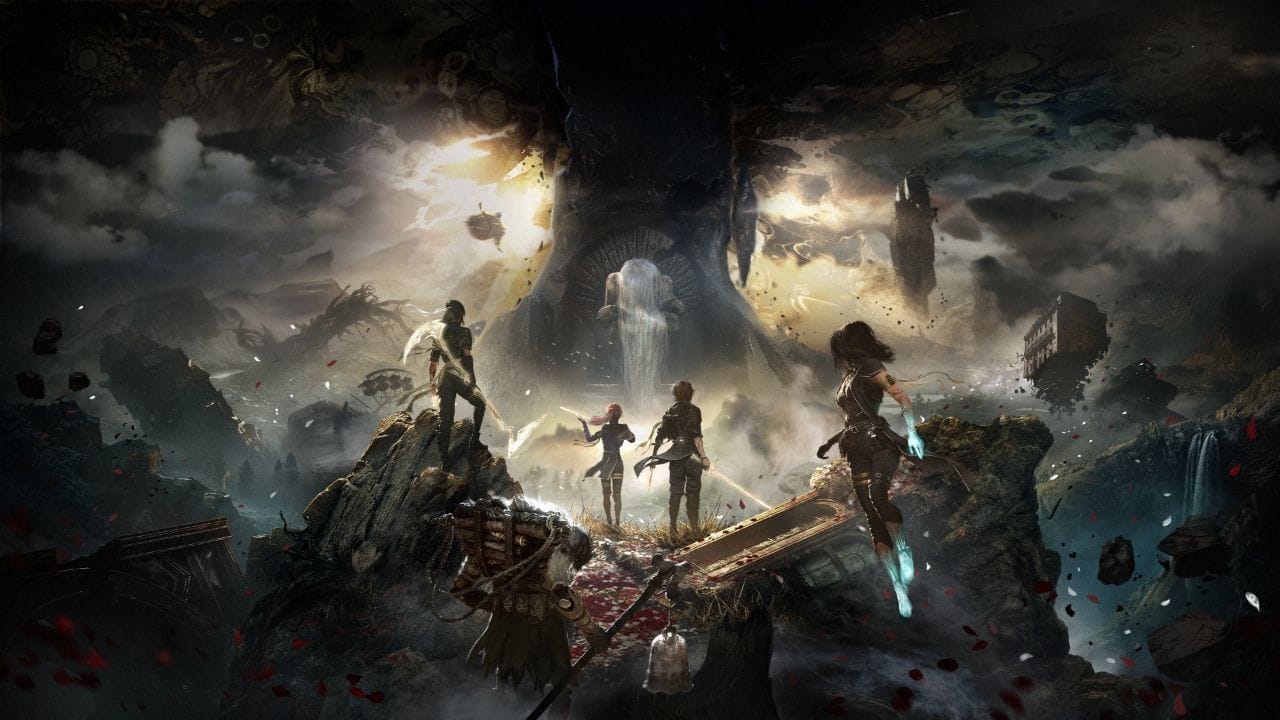
Clair Obscur: Expedition 33 is role-playing game (RPG or J-RPG) developed by the French studio Sandfall Interactive and published by Kepler Interactive.
The gameplay innovatively blends traditional turn-based RPG mechanics with real-time action elements (QTE, in jargon).
Released on April 24, 2025, the game is set in a dark fantasy world inspired by french Belle Époque era.
The game introduces players to the city of Lumière, which faces an annual catastrophe known as the “Gommage.” Each year, a mysterious entity called the Paintress paints a number, and all individuals of that age vanish instantly.
As the number reaches 33, a group of volunteers forms Expedition 33, determined to end this cycle of death by confronting the Paintress herself.
Built by a young, hungry team in the city of Montpellier in the South of France, founded by ex-Ubisoft dev Guillaume Broche.
It’s the result of six years of late nights, big bets, and fearless craft.
And it paid off.
By the time I’m writing these words, in less than 2 months, it sold an astounding 3.3 million copies.

A team of mostly juniors, defying the odds and rewriting the rules.
It’s more than a game. It’s a statement piece.
Contrast at the Heart.
Clair Obscur.
Even the title itself speaks of contrast.
Light and dark, hope and despair.
This tension drives the game’s emotional core.
The monolith, which is central in the game embodies that contrast: a beacon of hope, but also a stark reminder that time is running out.
Every year, another number is painted on it, marking humanity’s countdown to potential doom.
In design, contrast isn’t just visual. It’s narrative. It’s the push and pull that keeps users engaged, that makes an experience resonate on a deeper level.
And that sense of contrast extends beyond the narrative itself. Right down to the ways you can dress your characters.
Unique Look and Feel.
Like with the now-iconic marinière, béret, and baguette skin.
Part tribute, part cheeky French cliché.
Imagine fighting those huge bosses and watching emotional scenes with your characters dressed like this.
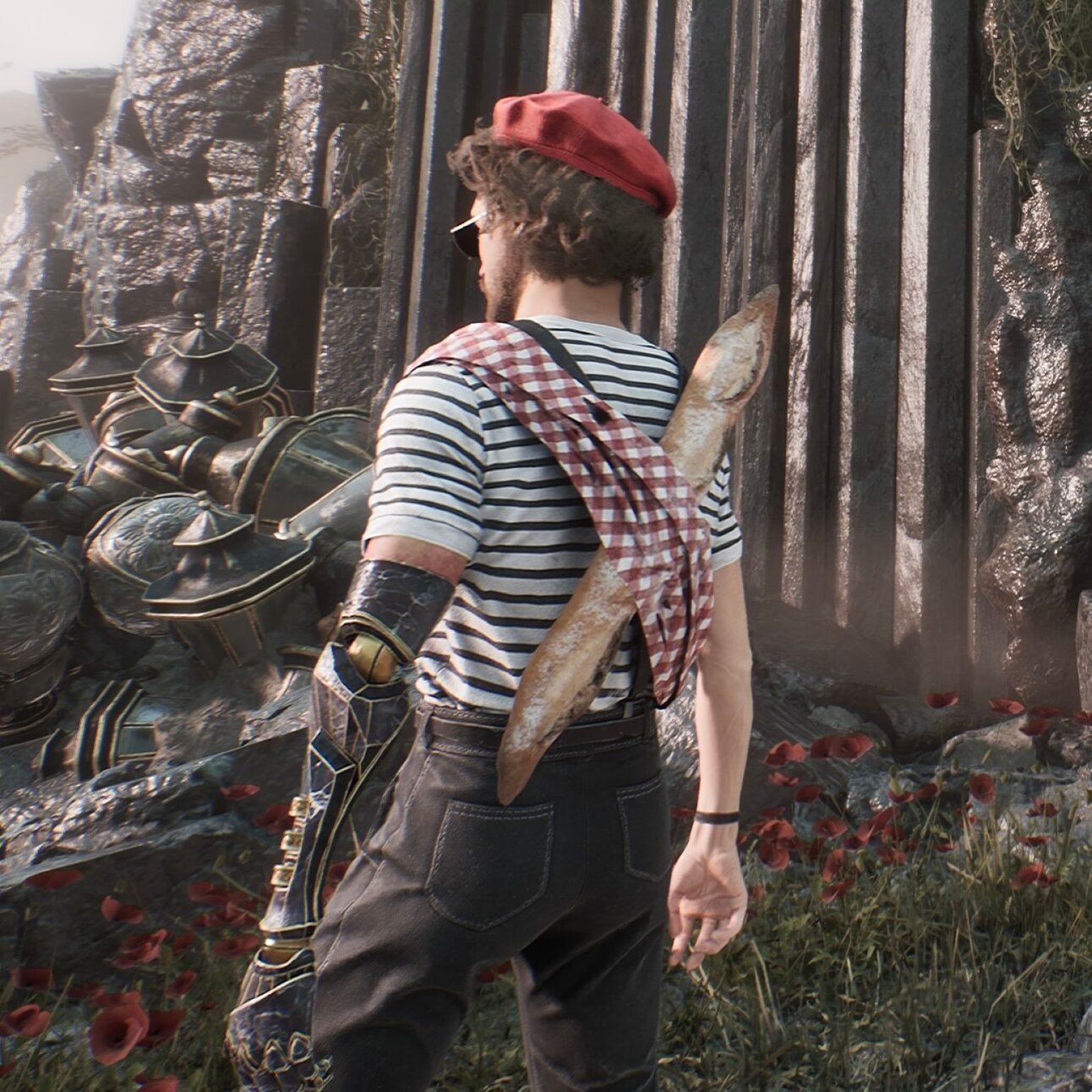
Le baguette du fromage 🇫🇷
It’s bold and quirky but 100% assumed and props to them for this.
Humor and easter eggs are fully embraced in the game.
I mean, they literally named one of their character just like their favorite energizing drink.
Another fun detail: the team loved playing pétanque at lunch so much, they named a character “Petank”, because why not?
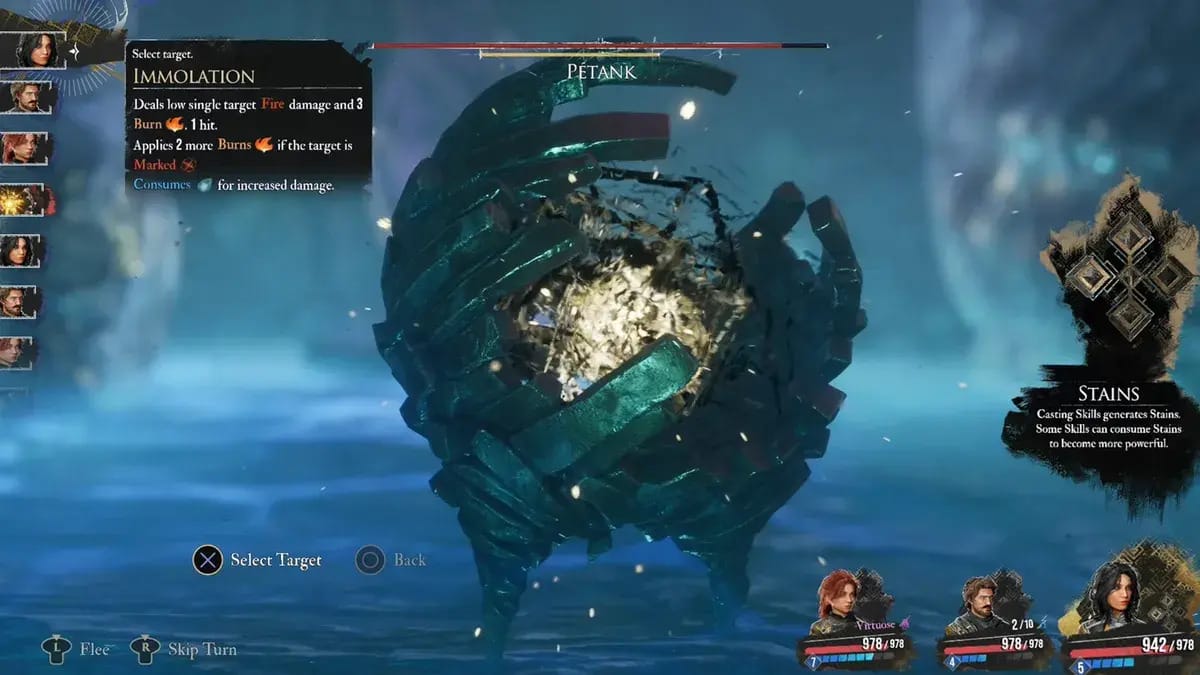
One of kind pétanque ball.
Such humor and cliché also helps adding a touch of smile in an environment mostly plunged in darkness .
The world feels both familiar and out-of-this-world.
You catch glimpses of Belle Epoque Paris with Haussmannian buildings and the Eiffel Tower, then wander landscapes that echo the Giants Causeway in Ireland — or even Maraudon from World of Warcraft, and all of a sudden you land in a beautiful Art Deco manor.
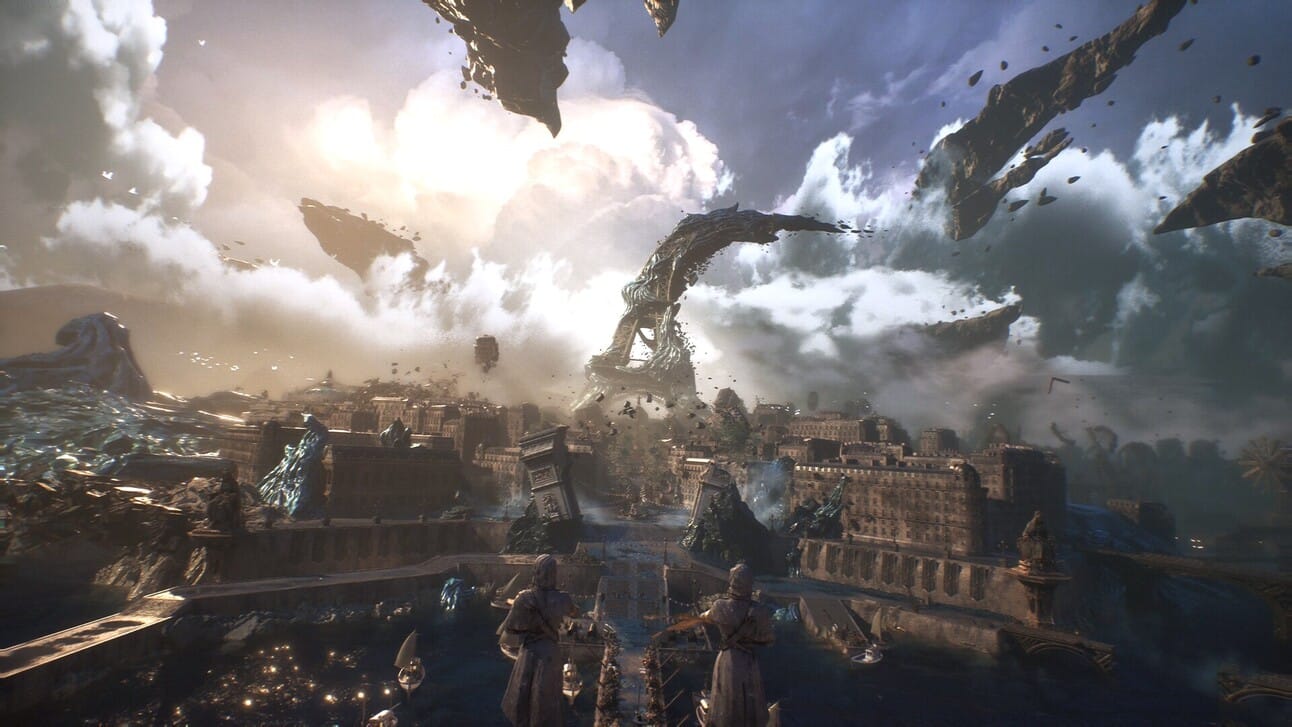
Lumière.
Clearly, the devs drew inspiration from everywhere.
But while the environment and art direction choices are tasteful, what really staggered me is the attention and craft given to the sound design and soundtrack.
A Legendary Soundtrack.
The game soundtrack, memes and thousands of covers have flooded YouTube, IG and TikTok lately.
It all starts by this simple story:
Guillaume discovered Lorien Testard, the composer, on an indie dev forum where he randomly posted his Soundcloud work. They chatted and it was the start of many years of collaboration.
It’s the first time Laurien, a guitar teacher, works on a game.
He created a 8-hour masterpiece, blending orchestra, digital and live instrumental recordings.
Don’t even get me started on Alice Duport-Percier, the talented vocalist of the soundtrack.
It took 5 years of dedication and craft to created the whole soundtrack.
Simply put, it’s the best game OST I’ve ever heard. I think the last time I was in owe with a game soundtrack, was with Anno 1800 done by Dynamedion, but this one hits so different.
Treat yourself and watch this if you want to hear a few beautiful samples.
Music and sound design is too often underestimated in games and apps.
It’s literally what anchors you the game forever. Years later, chances are, you’ll forgot about how cool a game was but you’ll never forget its music.
In a french interview Guillaume states:
Games often don’t live up to our memories… except for the music. That always stays magical.
Even you weren’t born in the 80s or never played these games, chances you’ll probably recognize Super Mario and Tetris signature sounds and music immediately.
Some sounds stay with you for life.
The Super Mario coin chime. The Pokémon healing tone. The Sonic ring loss.
Those sounds aren’t just nostalgia. They’re signals. Sonic logos. Micro-memories.
In Look & Feel Is Your Moat, I previously wrote that sound and haptics build trust.
Sound design matters more than people think. I know, most of us keep our phones on vibrate. Still. That satisfying click, that subtle confirmation chime, the quirkiness.
Sound and vibration aren’t gimmicks.
They’re memory glue.
To make sure encounters and fights in Clair Obscur are memorable enough, the team made sure to dynamically shift the music.
It always starts with a climatic intro, then it builds up, to soften a bit more during mid-battle especially if the fights gets longer preventing players to get some music fatigue, to only returns to a climactic pace in the final moments, carefully pared with some slo-mo sequences, providing a satisfying and rewarding feeling of accomplishment.
Stellar UX & Immersion.
The game, while heavily inspired by games like Sekiro, is easy to learn.
I think the team nailed the fact that it’s appealing for both casual players but also try-harders that might want to finish the game without taking a single hit (yes, you could do that).
They also made the game less overwhelming by limiting the amount of “active” spells and powers you can use during a fight, while providing a much more complex and deep “passive” mechanisms, outside of fights, so you have plenty of time to craft your own builds.
The results is that during fights, you don’t have to browse through an endless list of powers, which is often the case in similar games of that genre.
Immersion is at the core.
Outside of fights, there is absolutely no UI or buttons or any texts on screen.
You’re meant to play the game, just like you’re meant to watch a movie. Fully immersed.

Not a single UI, HUD or button in sight.
The game motion and transitions is also a work of art.
The way the cameras and viewports adjust to unobtrusively let the player know that action either needs to be taken, or happening is very satisfying.
Think of it as tiny movies plan sequences that also reinforce the game immersion.
During those focus modes, contextual menus open as overlays perfectly blending in the environment and characters. This quickly reminded me of Persona 5 game UI as well as some strong visionOS vibes.
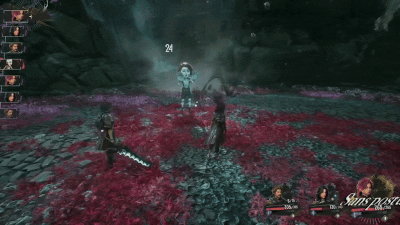
Contextual Flywheel UI.
Final Words.
Clair Obscur: Expedition 33 is more than a game.
It’s a blueprint for building products that resonate.
From its immersive art direction and narrative to its already iconic sound design, this small team from Montpellier teaches us that creativity often lives in the details.
As product builders, we should embrace that lesson and apply it to our own craft.
If I had to sum up keep one quote about the team behind the game, I’d keep this one, from Guillaume:
They were not formatted by the industry. Nobody told them it was impossible, so they did it
This resonates deeply.
It’s never been this true today, especially in our industries that need to think outside the box, to go that extra mile, the attention to details.
This game was created because one single person had an idea and wanted to play it very badly.
If you didn’t play Clair Obscur, or if you didn’t hear about it, I hope you this piece made you want to give it a try, or at least, watch a stream or review about it.
Let’s hope for an encore.
Julien.
This issue was a bit different and special, your feedback matters 🙏 You can also reply to this email if it’s been sent to you or directly to [email protected].
How much did you enjoy this special issue?
💌 Bring a Friend. Earn a Jam.
I’ve just launched referrals a few weeks ago so you can start refer friends and earn some jam/call sessions with me.
There will be cool new perks pretty soon.
In the meantime, we can:
🧠 Brainstorm on an idea, on a feature, on your next company.
🙌 Jam on Figma on your product together.
🌱 Talk about your career and how you can grow.
💰 Help you negotiate your next raise, your new job total comp or update your freelance daily rate.

